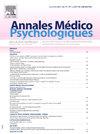自恋:综合概念、临床和经验知识,研究与身心健康的联系
IF 0.5
4区 医学
Q4 PSYCHIATRY
引用次数: 0
摘要
恶性自恋是一种人格障碍,在概念和临床文献中已经被广泛讨论了几十年。该综合征被认为既严重又极难治疗。近年来,恶性自恋的概念在流行话语中获得了动力,并且已经开展了对该综合征的实证研究。本文分为两部分。第一部分致力于对恶性自恋的概念、临床和实证文献进行综合,而第二部分则涵盖了恶性自恋与生理和心理健康之间关系的实证研究。部分关于恶性自恋的文献来源于心理动力学范式。关于恶性自恋的开创性著作强调了两个内在心理结构和相关过程的潜在作用:宏大的自我和未整合的超我。这些潜在组织的可观察表现分布在五个维度:自恋、精神病、侵略、虐待狂和偏执。基于人格障碍的维度模型,提出了三种评估恶性自恋的方法。第一个测量是恶性自恋综合指数,该综合指数依赖于国际人格障碍检查中的自恋和偏执倾向量表,以及精神病人格量表修订版中的无畏支配和冷酷量表。开发的第二个测量方法是恶性自恋的评分程序,该程序基于DSM-5的人格清单中评估的25个方面中的11个方面,这些方面是通过专家共识和原型匹配方法选择的。第三个测试是基于《精神病态人格量表修订版》中的“无畏支配”、“冷酷”和“以自我为中心的冲动”三个量表,以及《病态自恋量表》中的“浮夸型自恋”和“脆弱型自恋”两个量表。虽然恶性自恋综合指数是启发式引入的,尚未得到彻底的验证,而基于《精神病人格量表修订》和《病理性自恋量表》的指数仅在小样本中得到验证,但三种测量方法均显示出令人满意的结果。相比之下,基于DSM-5的人格清单的恶性自恋评分程序已经在大样本中得到验证,并显示出很强的心理测量特性。恶性自恋的测量,尤其是后者,已经被用来实证地记录恶性自恋的相关关系。研究表明,该综合征与社会人口学特征、人格功能和多种心理症状有关。数据也支持恶性自恋与密切相关的自恋型人格障碍和精神病之间的区别。恶性自恋的一个潜在关联还有待研究,那就是心理和生理健康。第二部分,背景人格障碍一般表现为身体健康问题以及较低的心理健康。因此,恶性自恋被认为与损害身体健康的行为以及各种心理困难有关。然而,MNARC的整体身心健康状况尚未得到实证研究。方法在加拿大魁北克省一家人格障碍专科诊所招募了288名人格障碍患者(178名女性,110名男性;Mage = 33.66, SD = 10.54)。他们完成了DSM-5分面简表人格量表的法语版,根据基于DSM-5人格量表的恶性自恋评分程序计算恶性自恋得分。他们还完成了法国版的《医疗成果研究短期健康调查》,该调查评估身体和心理健康。结果与讨论弱振幅的显著负双变量Pearson相关性表明,恶性自恋与较差的身体和心理健康以及受损的社会功能有关(医学结果研究简短健康调查的一般健康、心理健康和社会功能量表)。恶性自恋与身体健康之间的联系与先前关于人格障碍的文献一致。与身体健康的联系很少且很低,这可以用以下事实来解释:(a)恶性自恋包括原发性和继发性精神病,尽管有证据表明,后者更具体地与身体健康有关;(二)样本相对年轻,而人格障碍和身体健康问题之间的联系随着年龄的增长而增加。 评估具体的身体健康诊断会提供更细致的评估。由于恶性自恋被认为与有限的主观痛苦有关,因此预计其与心理健康和社会功能之间存在显著但较低的关联。本文章由计算机程序翻译,如有差异,请以英文原文为准。
Le narcissisme malin : synthèse intégrative des connaissances conceptuelles, cliniques et empiriques et étude des liens avec la santé physique et psychologique
Goal
Malignant narcissism is a personality disorder that has been extensively discussed in conceptual and clinical literature for decades. The syndrome is postulated to be both severe and extremely difficult to treat. In recent years, the notion of malignant narcissism has gained momentum in the popular discourse, and efforts at empirically studying the syndrome have been undertaken. This paper is organized in two parts. Part I is dedicated to an integrative synthesis of conceptual, clinical, and empirical literature on malignant narcissism, while Part II covers an empirical study on the associations between malignant narcissism, and physical and psychological health.
Part I
Literature on malignant narcissism originated from the psychodynamic paradigm. Seminal writings on malignant narcissism highlight the underlying role of two intrapsychic structures and related processes: the grandiose self and an unintegrated superego. The observable manifestations of these underlying organizations are distributed across five dimensions: narcissism, psychopathy, aggression, sadism, and paranoia. Three measures relying on the dimensional model of personality disorders have been proposed to assess malignant narcissism. The first measure is the Composite Index of Malignant Narcissism, which relies on the Narcissism and Paranoid Proneness scales from the International Personality Disorder Examination, and the Fearless Dominance and Coldheartedness scales from the Psychopathic Personality Inventory-Revised. The second measure developed is a scoring procedure for malignant narcissism based on 11 of the 25 facets assessed in the Personality Inventory for DSM-5 selected through an expert consensus following a prototype matching approach. The third measure is based on the three scales from the Psychopathic Personality Inventory-Revised, Fearless Dominance, Coldheartedness, and Self-Centered Impulsivity, as well as the two scales of the Pathological Narcissism Inventory, Grandiose and Vulnerable Narcissism. The three measures showed promising results, although the Composite Index of Malignant Narcissism was introduced in a heuristic perspective and has yet to be thoroughly validated, while the index based on the Psychopathic Personality Inventory-Revised and the Pathological Narcissism Inventory was only validated in a small sample. In contrast, the scoring procedure for malignant narcissism based on the Personality Inventory for DSM-5 has been validated in large samples and has showed strong psychometric properties. Measures of malignant narcissism, especially the latter, have been used to empirically document the correlates of malignant narcissism. Research shows that the syndrome is linked to sociodemographic characteristics, personality functioning, and multiple psychological symptoms. Data also support the distinction between malignant narcissism and the closely related narcissistic personality disorder and psychopathy. A potential correlate of malignant narcissism that has yet to be studied is psychological and physical health.
Part II, Background
Personality disorders in general present with physical health problems as well as lower psychological health. Accordingly, malignant narcissism is postulated to be linked to behaviors that can damage physical health, as well as various psychological difficulties. However, global physical and psychological health in MNARC have yet to be empirically studied.
Methods
A total of 288 participants (178 women, 110 men; Mage = 33.66, SD = 10.54) with a personality disorder were recruited in a specialized clinic for personality disorders in the province of Quebec, Canada. They completed the French adaptation of the Personality Inventory for DSM-5 Faceted Brief Form to compute malignant narcissism scores according to the scoring procedure for malignant narcissism based on the Personality Inventory for DSM-5. They also completed the French adaptation of the Medical Outcomes Study Short-Form Health Survey, which assesses physical and psychological health.
Results and Discussion
Significant negative bivariate Pearson correlations of weak amplitude indicated that malignant narcissism is linked to poorer physical and psychological health, as well as impaired social functioning (General Health, Mental Health, and Social Functioning scales of the Medical Outcomes Study Short-Form Health Survey). The uncovered links between malignant narcissism and physical health are coherent with previous literature on personality disorders. The few and low associations with physical health can be explained by the fact that (a) malignant narcissism comprises both primary and secondary psychopathy, although evidence suggest that it is more specifically the latter that is linked to physical health; and (b) the sample was relatively young, while the links between personality disorders and physical health problems increase with age. Assessing specific physical health diagnoses would have provided a more fine-grained assessment. Significant but low associations with psychological health and social functioning were expected since malignant narcissism is postulated to be associated with limited subjective distress.
求助全文
通过发布文献求助,成功后即可免费获取论文全文。
去求助
来源期刊

Annales medico-psychologiques
医学-精神病学
CiteScore
1.30
自引率
33.30%
发文量
196
审稿时长
4-8 weeks
期刊介绍:
The Annales Médico-Psychologiques is a peer-reviewed medical journal covering the field of psychiatry. Articles are published in French or in English. The journal was established in 1843 and is published by Elsevier on behalf of the Société Médico-Psychologique.
The journal publishes 10 times a year original articles covering biological, genetic, psychological, forensic and cultural issues relevant to the diagnosis and treatment of mental illness, as well as peer reviewed articles that have been presented and discussed during meetings of the Société Médico-Psychologique.To report on the major currents of thought of contemporary psychiatry, and to publish clinical and biological research of international standard, these are the aims of the Annales Médico-Psychologiques.
 求助内容:
求助内容: 应助结果提醒方式:
应助结果提醒方式:


